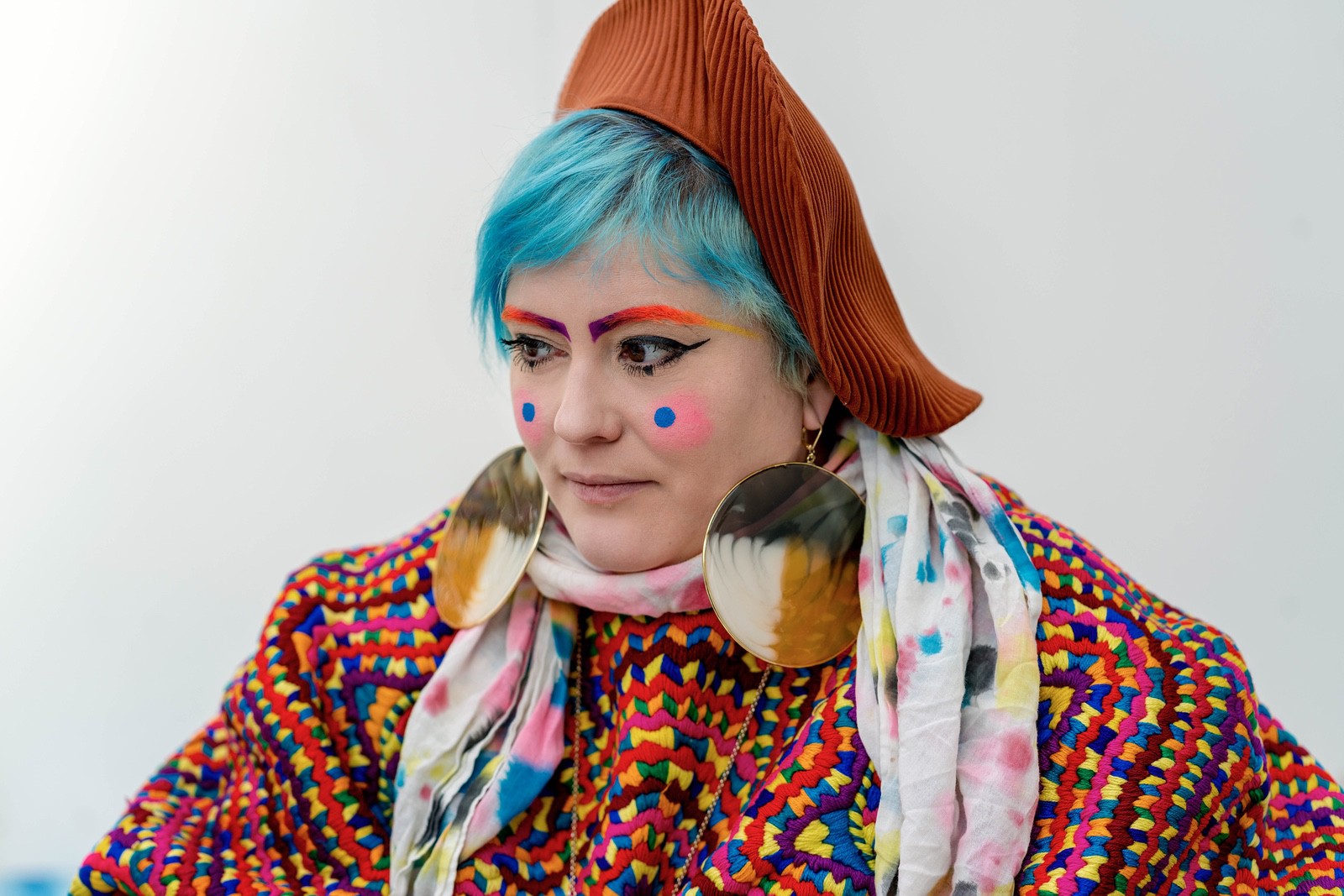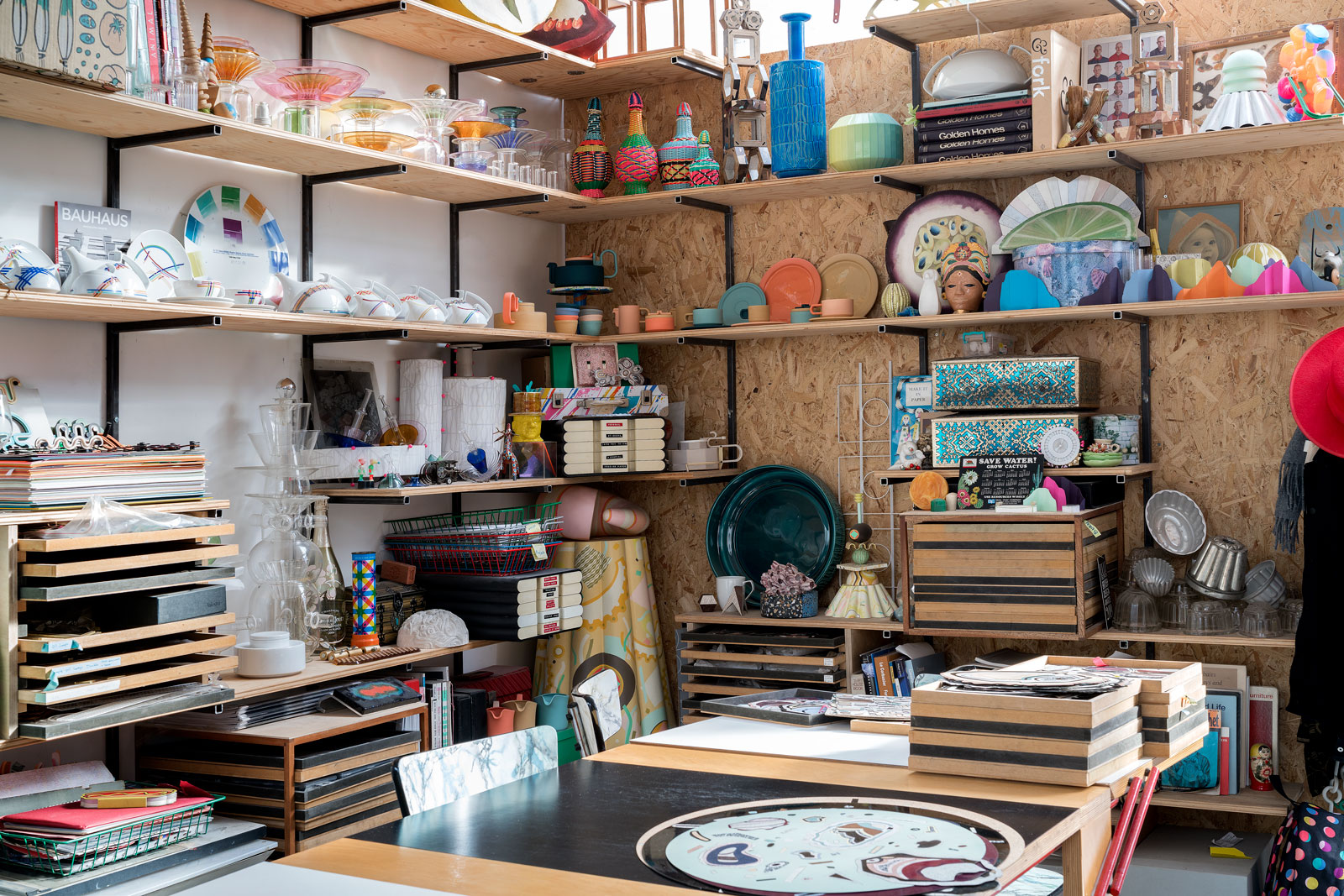‘Oysters,’ a collection of laminate marquetry ovals, are spread out on the London studio desk of designer Bethan Laura Wood, who casts herself in the role of magician or alchemist of surfaces by creating luxury pieces out of inexpensive material. “I just love that with marquetry technique you can make this kind of cross section of the laminate. You see, we go from a basic kind of matt navy, to this aggressive surface, then to this bonkers glittered, to this one that’s meant to be like a wood, to this standard Memphis black laminate.” Once they are finished, she will press the oysters to a backing board, an mdf or a ply, and use them to make tables and cabinets.
An early example of this technique is her Moon Rock table from the Super Fake series (2011) that stands tilted like a small solar panel against her drawing table. “It was inspired by the craters on the moon and the compositions in the solar system.” Today, she has come up with a new series in warmer color variations, a decision she made quite instinctively. “When I was in Mexico, I was with Danae, my wonderful friend from Greece who used to work for me, and she was laughing because all of the things I kept on picking up – the textiles, objects – were much more brown than she had ever seen me pick up before. She was like, ‘What are you doing!?’ And it was all because I was trying to understand a different palette from the ones I’ve worked with previously.”
The studio, a colorful cabinet of curiosities, has a collection of eclectic and outlandish objects. Blue, pink and pistachio corals made of aluminum rise flat on the wall creating the illusion of a little submerged garden. “Those are prototypes from when I did a project for Hermès. There was a mistake in the laser cutting. They cut more than we needed, so they kinda found their way onto my wall and they look pretty happy up there.” On a shelf, Wood’s Japanese inspired candelabra sits next to a stool built by her designer friend Fabien Capello. “He had made twenty of them using wood from disposed Christmas trees – not the easiest kind to manipulate. I remember he put them all in the skip, and I took them all out because I thought they were really cool. Over the course of the rest of that term, he just slowly took them all back, because when he had a little bit of time away from the project, he realized there was actually something really interesting in it and he was gonna develop it further. Now he lives in Mexico, so I think I have to make him make them from Mexican trees!”

I’m drawn to physical objects as part of my reference making.
Bethan Laura WoodAcross the room, on a high shelf, a charming vintage 1960’s ceramic Aldo Londi blue dachshund dog hides in the shadow of a giant hand-painted piece of passion fruit used in her Henri Rousseau inspired scenography for Hermès. And on the shelf below, “That’s Margot there, one of the little ones,” she says pointing to a little yellow modular decorative sculpture hinting at party food from the 1960s and 1970s. It belongs to a traveling installation she created for Tory Burch to celebrate Burch’s collaboration with Palm Beach ceramicist Dodie Thayer to revive the lettuce-themed plates.
Three little glass sculptures looking like retro mini satellite dishes stand in between paper models of her Guadalupe ceramic vase variations with patterns borrowed from the stained-glass windows of the New Basilica of Our Lady of Guadalupe in Mexico City. The paper models may not transmit light like the stained glass windows would, but the glass sculptures do. They are called Flowers and are made by glass artisan Pietro Viero. They will be clustered onto a circular metallic frame, the Trellis chandelier. Trellis is not the first series of lights she has created with Viero. Their relationship goes back to Totem, where they layered and locked together various glass volumes to create unusual lights. “Borosilicate glass (pyrex) is a material normally used for science ware or kitchenware, a more industrial glass than let’s say an artisanal. I‘ve really enjoyed finding the non-industrial ways of working with it that, in particular, come from Pietro’s specialism.”
In the studio next door, which belongs to her friend Fernando Laposse, three lamp prototypes are arranged on a desk. Part of her expanding vocabulary of glasswork, Blooms coincidentally match the color of the Mexican designer’s wall panel with its unique surface veneer made from the naturally colorful native Mexican corn husks (Totomoxtle).


Wood, who’s always had a soft spot for Eduardo Paolozzi, says that her most preferred artist intervention is the mural he made at Tottenham Court Road tube station – parts of it now displayed in a museum in Scotland. “It was a little treat awaiting you in this space where thousands of people passed through, back and forth, every day.” Making an intervention in a tube station, “is something I really would ravish the opportunity to do.” Even though public art is meant to be enjoyed by many people, the objects she designs are owned by a few. “I’m not a designer whose specialism is making multiple mass-produced items. I don’t devalue the importance of designers who do that, but I also don’t think that there is a need for every designer to only ever do that kind of volume work. Design is such a wide and exciting discipline, so I think there is space for all different types of work that suit different volumes of production. We also as a society have enough stuff as it is !”
Despite thinking we all have enough stuff, Wood won’t resist acquiring any kind of curiosity she finds in a market. “I really love going to live markets. It can be food markets, it can be fabric markets, it can be anything. I pick up fabrics, textiles, ceramics, plastics, anything, you name it. I’m drawn to physical objects as part of my reference making.” The Scooby-Doo bottles she had once picked up, for instance, became one of the references for Rhythm, the pattern Bethan developed to complement the classic TAC tea set design by Walter Gropius. While Tongue, like Rhythm, is a part of Rosenthal’s celebration of 100 years of Bauhaus, the color and body are wholly her own design, “with a nod to the proportions of TAC and the conversation its handle has with its lid,” she notes.
Wood’s attraction for color and patterns is an obsession and driver of her distinctive aesthetic. She was timid in her teenage years about combining “a large amount of stuff and pattern all together,” but at the Royal College of Art, “they were, like, ‘Why not?! It is something, you can do and you should use it.’” She had dreamed about going to the RCA since she was about 16, when she was still living in a medium-sized town in the Midlands and caught on TV a BBC documentary series on the RCA. “I just knew that’s where I needed to go.” But when she got there, she felt pure panic. “When it’s something that you’ve spent so long aspiring towards and you get there, it’s a lot of pressure. At one point I was finding it very difficult to be in the building itself.” Her tutors, Italian designer Martino Gamper and Dutch designer Jurgen Bey, helped her surpass this mental block and be the designer that she is today. “Martino has definitely been a mentor to me. The influence of his idea of playing and physically building something and not getting too stuck or worried about what you are doing, of exploring whilst making, is very strong.”
A teacher herself, she taught a course in design and luxury at ECAL for almost seven years. “Imagine having to take in 13 or 20 students’ takes on an idea and trying give them each different feedback without pushing each student into what you might do, because it’s not about you. It’s about what they are doing. The brain power it sucks: it’s quite a lot. You don’t think it is, but after two days of teaching you are like, ‘whoa.’” Last year, she took a break from teaching and went back to being part of the jury, something she would like to do more of in the future. “It’s sometimes quite good to have a little break, because you need to be fresh and be able to bring new things to the conversation.”
HyperNature
Over the years, she has grown more confident about being able to do different types of work and has taken up more installation-based projects. The tree HyperNature, an artistic commission from Maison Perrier-Jouët, is one such example and one of her biggest pieces. “What’s come now is the carcass of the tree,” she says pointing to the wooden box that has been shipped from Neal Feay Studio in the US. “Guglielmo [her assistant] will take a peek to see if it looks like it’s ready for a close up.” An hour later the aluminum tree has been put together and is ready to be dressed with the hand-dyed PVC petals that are pinned on the wall. “The tree will travel to various countries and then return to Epernay, the family home of Maison Perrier-Jouët. They find locations within the Maison for it to kind of live in a retired fashion.”

Fashion for her is bold and joyous, part performance and part visual language. Her top is woven in vibrant colors that blend into one another giving a beautiful effect. Her skirt is baggy and monochromatic with a subtle pattern. She wears pointy shoes with woolen pompons, typically worn by a group of elite Greek soldiers (Evzones), a present from her dear Greek friend Danae. Her hair is neon blue. Her doll-like cheeks are painted with blue circles and her eyebrows are rainbow colored. “I’ve always enjoyed dressing up. When I was younger everybody thought I was a fashion designer and I was, like, no no no. I’m doing this, but I can look like this. I’m aware that my personal choice of dressing up has helped to create more of a signature look for people to know who I am. It has become a part of my narrative, my identity within design.”

London, 2019. All photographs and text © 2019 by Alexia Antsakli Vardinoyanni – www.artflyer.net














